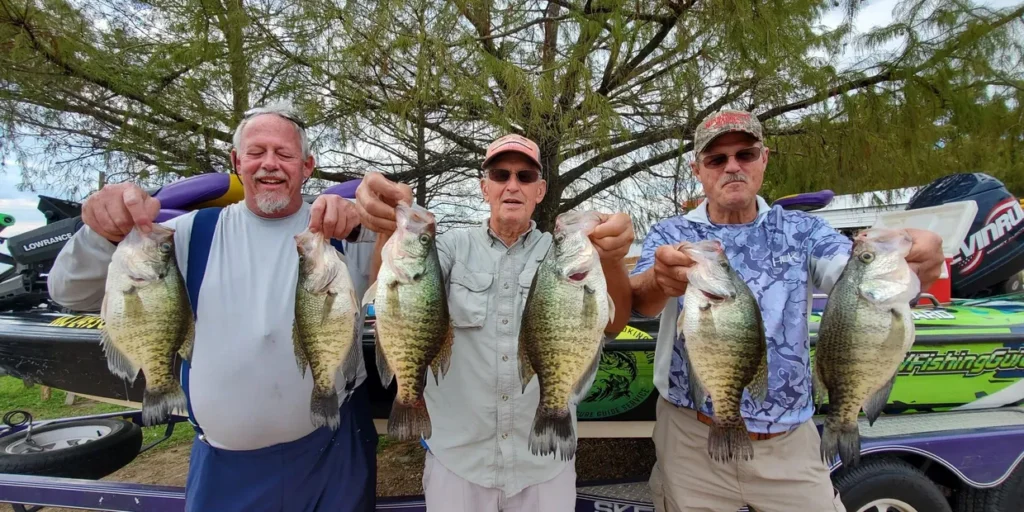Crappie Fishing on Lake Fork, Texas: An Angler's Seasonal Guide
Lake Fork, Texas, is renowned not only for its bass fishing but also as one of the premier destinations for crappie fishing in the United States. Known for its robust populations of both black and white crappie, Lake Fork offers anglers exceptional year-round fishing opportunities. This comprehensive guide explores the best times to fish and the most effective baits to use throughout the year, ensuring you have a productive outing on this storied lake.
Understanding Crappie Fishing on Lake Fork

Lake Fork was impounded in 1980 and spans over 27,000 acres, with a maximum depth of about 70 feet. The lake’s structure includes submerged vegetation, bridge columns, and timber, providing ideal habitats for crappie. The lake is managed to enhance fishing experiences, with numerous fish attractors placed strategically to promote healthy crappie populations.
Best Times to Fish for Crappie
Spring (March to May): Spring is the prime season for crappie fishing on Lake Fork as the fish move into shallower waters to spawn. The warmer waters trigger crappie to leave their deeper, winter habitats and prepare for the spawning process, making them more accessible and aggressive. Look for crappie around submerged structures like timber in coves or near creek channels.
Summer (June to August): As temperatures rise, crappie tend to move deeper to find cooler, more oxygenated water. During early morning and late evening, they may come back to shallower waters to feed. Fishing at night can be particularly fruitful during the hot summer months.
Fall (September to November): Fall can be a rewarding time for crappie fishing as the fish are actively feeding to bulk up for the winter. During this season, crappie can be found in both shallow and deep water. As the water cools, they often move back to mid-depths, making them easier to target around structures.
Winter (December to February): Winter fishing can challenge even seasoned anglers as crappie move to deeper waters and become less active. However, with patience and the right techniques, you can still enjoy successful outings. During sunny days, crappie might move to shallower water to feed, providing a perfect opportunity for anglers.
Best Crappie Baits and Techniques for Each Season
Spring:
- Minnows: Live minnows are very effective as crappie are preparing to spawn and are on the lookout for easy meals.
- Jigs: Small jigs mimicking the appearance of crappie’s natural prey can be very effective. Light colors work best in the clearer spring waters.
- Crappie Spoons: These can be useful for deeper or suspended fish, especially in clearer areas.
Summer:
- Small Fish Imitations: As baitfish populations grow, using lures and jigs that mimic these small fish can be effective.
- Minnows and Nightcrawlers: Live bait can attract the crappie’s attention in deeper waters.
- LED Light Fishing: Attracting crappie with lights and then using live bait or jigs can yield good results at night.
Fall:
- Spinners and Jigs: These remain effective as they can be used at varying depths to find where crappie are holding as the water temperature drops.
- Minnows: As the water cools, minnows continue to be a top choice for enticing crappie.
- Crappie Tubes and Marabou Jigs: These can mimic the natural movement of prey through the water, appealing to the predatory instincts of crappie.
Winter:
- Ice Jigs: If the water gets cold enough, ice fishing tactics can sometimes be applied, particularly in the deepest parts of the lake.
- Vertical Jigging: With crappie holding in deeper water, vertical jigging right where the fish are located can be effective.
- Minnows: Using live bait in deeper areas where fish congregate during the winter can produce bites in the slower season.
Additional Tips for Successful Crappie Fishing on Lake Fork
- Hire a Guide: If you’re new to Lake Fork or crappie fishing in general, consider hiring a guide who knows the lake well. They can provide invaluable insights into crappie movements and habits.
- Pay Attention to Water Temperature: Crappie behavior changes with water temperature, so keep a thermometer handy and note the temperatures when you find active fish.
- Keep an Eye on the Weather: Crappie can be sensitive to changes in pressure and weather. Overcast days often lead to better fishing.
Crappie fishing on Lake Fork offers a thrilling experience for anglers of all levels. By understanding the seasonal patterns and adapting your techniques and baits accordingly, you can greatly increase your chances of a successful fishing trip. Whether you’re a novice hoping to catch your first crappie or an experienced angler looking to land a trophy, Lake Fork’s abundant waters provide ample opportunity for everyone. With the right approach, every season can yield a rewarding harvest of this popular freshwater game fish.